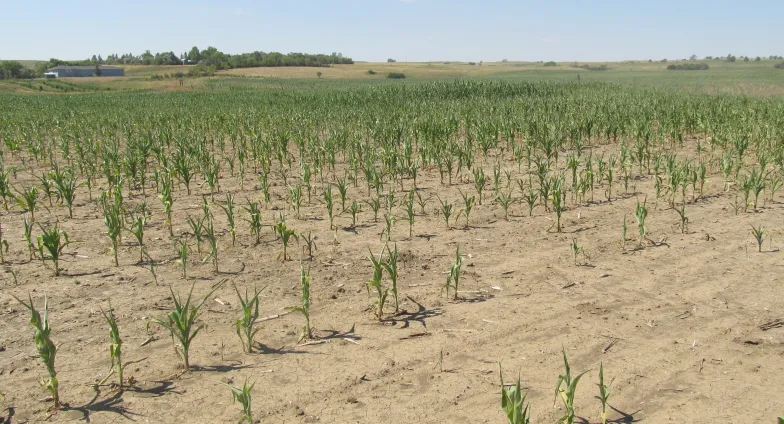Dry Seedbeds Require Special Tactics or Rain
Under dry seedbed conditions it is true that planting on schedule may result in uneven stands. However, this is preferable to planting too late.
June 2017
Hans Kandel, NDSU Extension Agronomist
Whether fields are dry or not, farmers should stick as closely as possible to the recommended planting schedule for each crop. Late planting can sharply reduce yields of small grains, flax, corn, canola, dry peas and mustard, especially if temperatures are above normal and spring planting operations are ahead of normal.
Under dry seedbed conditions it is true that planting on schedule may result in uneven stands. However, this is preferable to planting too late. If rains do come later, most seeds will germinate if adequately protected with a seed treatment. Some soil crusting could present a problem if seeds are slow to germinate, so farmers should be aware of this possibility.
To minimize dryness problems, tilling should take place at a shallow depth and producers should cut down on seedbed operations before planting. Direct-seeding or no-till maybe the best option in a dry year. It also is suggested that post-emergence herbicides be used rather than preplant soil-incorporated herbicides that can cause additional soil drying and may not be as effective in dry soil.
Press drill planting should be at a shallow depth. Roots will not grow through dry soil even if the seeds germinate. Use deep furrow hoe drills when available to reach soil moisture. Small grains and flax can be drilled directly into standing sunflower stubble with disc opener drills.
A double disc drill is not as effective as a no-till drill, a hoe drill or an airseeder in seeding to moisture in standing stubble. It may be beneficial to harrow first and scatter the straw of the previous year’s crop residue prior to seeding.
If newly emerged weeds are present, use a nonselective, burn-down herbicide before seeding. Some residual weed control may be present from dinitroaniline herbicides (Trifluralin, Prowl or Sonalan) used in the previous year, if it was extremely dry in your area. However, be ready to spray and control volunteer sunflowers or other crop volunteers if they emerge with the crop.
Here are 10 suggestions to minimize effects of planting into dry soils:
- Avoid excess tillage prior to planting. Each tillage operation causes soil moisture losses.
- Use shallow tillage (3 inches or less) to destroy weeds and firm the seedbed.
- Avoid the use of premerge soil-incorporated herbicides on crops where postemergence herbicides are available and economical to use.
- Plant small grains directly into standing sunflower stalks, soybean, canola or dry edible bean stubble.
- Crops, such as corn, sunflower, field peas and dry edible beans can be planted deeper (2 to 3 inches maximum). Flax, mustard, canola, proso millet or buckwheat should be planted at a depth of 1 inch or less. Intermediate planting depths of 1 to 2 inches are best for wheat, durum, barley, oats, lentils and soybeans.
- In general, large-seed-sized varieties of wheat or durum, oats and barley can be seeded slightly deeper than small-seed-sized varieties.
- Seed treatments on small grains should be uniformly applied at labeled rates to maximize seedling emergence. Over treatment on some seeds and little to none on others can cause erratic stands.
- If rains come after planting, watch for soil crusting. Break soil crusts with light harrowing or use a rotary hoe.
- Consider post-plant applications of nitrogen in the form of urea if good moisture conditions develop later. Rain usually is required in 48 hours after application to reduce N losses due to volatilization. Side dress N between the rows in corn and sunflowers once the crop is established and has the potential to produce a crop.
- If fairly good stands are established, but dry soil conditions continue, plan a good weed control program to help conserve soil moisture for crop growth and development. Harrow annual weeds when small or just prior to emergence for control without the use of herbicides.
